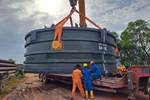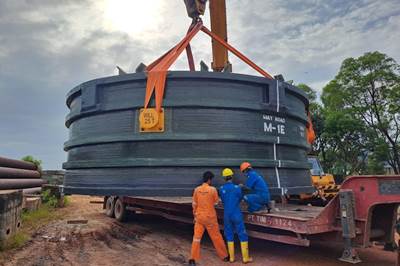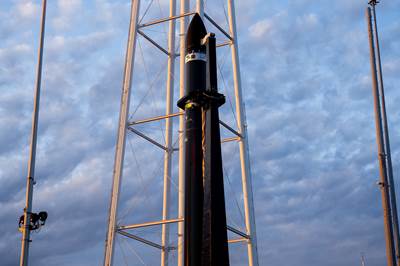Looking at composites through the lens of U.S. history
When you’re a tourist with a background in writing for manufacturing it’s impossible not to notice all of the ways in which composites have resulted in significant milestones in the U.S. — historically and in the present.

The Smithsonian’s National Air and Space Museum in Washington, D.C. Source | CW
It’s been a busy spring filled with international travel, facility tours and industry events. Like many of you, I find myself pulled in many directions — managing schedules, collaborative projects with my company’s various brands, event planning, editorial deadlines and writing projects. Numerous stories have been occupying my mind lately, including an account of what I witnessed at JEC World in Paris and write-ups from various composites-related plant tours.
In the middle of all of this, spring break rolled around. Instead of opting for a relaxing vacation, my wife and I took our kids to Washington, D.C. and spent a week walking the streets of our nation’s capital, taking in the monuments and museums. It was exhausting, but also inspiring. As we took tours and visited exhibits that explored the history of the U.S., I found myself thinking a lot about my own work, sharing the developments and stories in the manufacturing space. Manufacturing itself is intertwined with our history, and what I have learned — having explored various industries through my time with CW and sister publication Products Finishing — gave me a new perspective than I had the last time I visited D.C.
Composites will no doubt reshape our future.
For instance, as we toured the National Air and Space Museum, I found myself looking at a placard discussing the increasing use of composites in commercial airliners. It was only a brief blurb outlining the progression of composites use to date, with a discussion of the Boeing 787 Dreamliner and various aspects of Airbus A350, but there it was; I pulled my kids over to read it.
We’d go through exhibits on space exploration and the moon landing, and I found myself secretly noting each mentioned use of composites and ticking off a mental list of company names for various aspects of each piece of equipment.
Throughout the trip, I’d also checked the news, finding even more reminders of the growing role composites play in our daily lives. One announcement was that Boeing’s CEO, Dave Calhoun, will be stepping down at the end of 2024, along with several other key management changes — moves made by Boeing in the wake of quality control difficulties plaguing the company, largely surrounding incidents with the 737 Max. All of this continues to add to the speculation as to when some sort of announcement of a new mid-market aircraft program from Boeing or Airbus might happen. When a new program is finally announced, it’s almost certain that composite materials will play an important role.
And then, the morning of my second day in D.C., the Francis Scott Key Bridge in Baltimore, Maryland, collapsed when a massive container ship lost power and crashed into it, halting the flow of ships in and out of Baltimore. The tragedy sparked a new round of discussion surrounding the state of bridge infrastructure throughout the U.S. This, in turn, linked to a bipartisan Infrastructure Law implemented in 2021, announcing more than $185 billion in funding for a host of infrastructure projects including bridge and road repair, and the more than 7,800 bridge repair projects currently underway as of November 2023. Composites are playing a large role in such initiatives, lending material options including GFRP rebar as an alternative to steel for reinforcing concrete in roads as well as FRP panels and decking.
Looking back at the history of how a country built itself, and then reflecting on history unfolding presently, it’s exciting to see the increasing role composites are playing in a variety of sectors from aerospace to infrastructure to transportation. As we continue to build and rebuild the world around us, composites will no doubt continue to offer an important material solution that will reshape our future.
Related Content
Revisiting the OceanGate Titan disaster
A year has passed since the tragic loss of the Titan submersible that claimed the lives of five people. What lessons have been learned from the disaster?
Read MoreBack in the composites saddle
The CompositesWorld team looks ahead to upcoming composites industry events and opportunities for the remainder of the year.
Read MoreHow has CW changed in the last year?
Upon his one-year anniversary as editor-in-chief of CW, Scott Francis looks back at some of the brand’s changes and hints at where it might be heading next.
Read MoreA return to JEC World
CW editor-in-chief Scott Francis reflects on the ways in which the composites industry has changed and also stayed the same based on observations from this year’s JEC World.
Read MoreRead Next
Composites end markets: Infrastructure and construction (2024)
Composites are increasingly used in applications like building facades, bridges, utility poles, wastewater treatment pipes, repair solutions and more.
Read MoreRocket Lab receives U.S. Space Force launch contract for DOD operations
The mission will be Rocket Lab’s third for the U.S. Space Force, further strengthening the use of its Electron carbon fiber composite rocket as a reliable and responsive small launch vehicle.
Read MoreAll-recycled, needle-punched nonwoven CFRP slashes carbon footprint of Formula 2 seat
Dallara and Tenowo collaborate to produce a race-ready Formula 2 seat using recycled carbon fiber, reducing CO2 emissions by 97.5% compared to virgin materials.
Read More






















